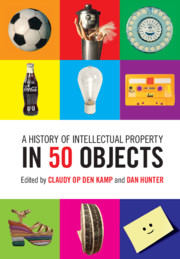Book contents
- Frontmatter
- Dedication
- Contents
- Acknowledgments
- Introduction: Of People, Places, and Parlance
- The Pre-Modern Period
- The Age of invention
- 5 Hogarth Engraving
- 6 Lithograph
- 7 Morse Telegraph
- 8 Singer Sewing Machine
- 9 Uncle Tom's Cabin
- 10 Corset
- 11 A.G. Bell Telephone
- 12 Light Bulb
- 13 Oscar Wilde Portrait
- 14 Kodak Camera
- 15 Kinetoscope
- 16 Deerstalker Hat
- 17 Paper Print
- Modern Times
- The Consumption Age
- The Digital Now
- About The Contributors
15 - Kinetoscope
from The Age of invention
Published online by Cambridge University Press: 12 June 2019
- Frontmatter
- Dedication
- Contents
- Acknowledgments
- Introduction: Of People, Places, and Parlance
- The Pre-Modern Period
- The Age of invention
- 5 Hogarth Engraving
- 6 Lithograph
- 7 Morse Telegraph
- 8 Singer Sewing Machine
- 9 Uncle Tom's Cabin
- 10 Corset
- 11 A.G. Bell Telephone
- 12 Light Bulb
- 13 Oscar Wilde Portrait
- 14 Kodak Camera
- 15 Kinetoscope
- 16 Deerstalker Hat
- 17 Paper Print
- Modern Times
- The Consumption Age
- The Digital Now
- About The Contributors
Summary
THE HISTORY OF film and media technology often seems to move backwards as well as forwards. Synchronized sound and color films, for example, appeared and disappeared for decades before they became industry standards. And 3D movies continue to come and go in waves. The stops and starts of media history can have many causes: technologies are insufficiently developed, businesses fail to promote them effectively, or the social integration of new media technology takes a wrong turn. Media revolutions may begin in the laboratory, but they don't take hold unless all of the pieces are aligned. And it is not uncommon for technological advances to lay dormant for centuries until they can be successfully employed and enjoyed.
When motion pictures emerged simultaneously in Europe and the United States in the last decade of the 19th century, they existed in a heterogeneous environment filled with possibilities, ultimately ending with a mix of success stories and failures. Some investors incorporated movies into amusement parks and world's fairs, creating early film rides. Others projected film in vaudeville and music hall theaters, extending the traditions of popular theater. And Thomas Edison's short-lived Kinetoscope created a personalized viewing experience that disrupted social norms and legal regulation before it submerged again, only to be reborn, we might argue, more than a century later.
Edison first set a team in his lab working on motion picture technology in 1888 after he witnessed photographer Eadweard Muybridge's studies of animal locomotion. Over the next few years, the team experimented with many different methods of reproducing moving images, and they incorporated ideas from collaborators and competitors. After trying a number of unsuccessful formats, Edison's lab settled on George Eastman's flexible celluloid film, which proved to be both pliable and tough enough to wind through the gears of a film camera. Edison soon added sprocket holes to move the celluloid even more effectively, as French scientist Etienne-Jules Marey and others had done.
- Type
- Chapter
- Information
- A History of Intellectual Property in 50 Objects , pp. 128 - 135Publisher: Cambridge University PressPrint publication year: 2019

